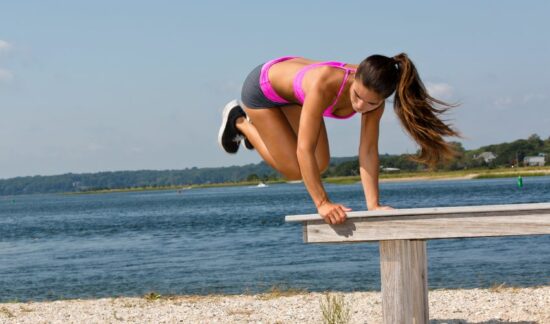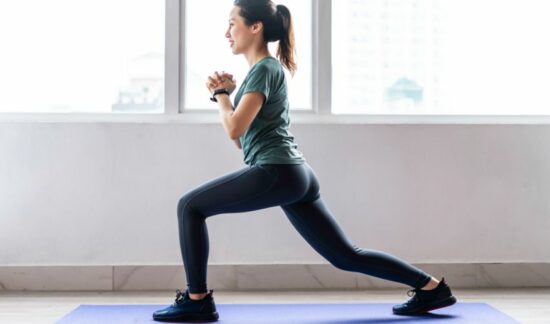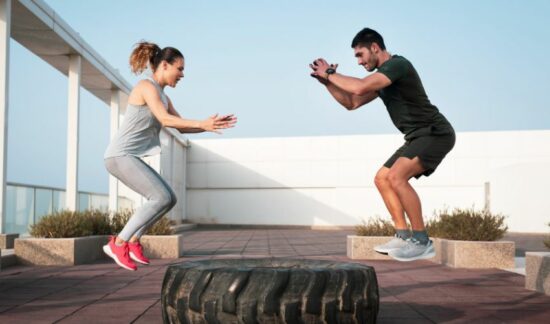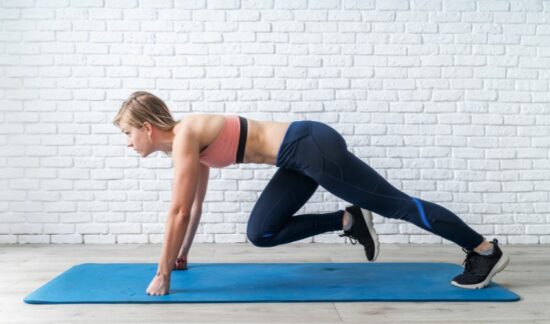Plyometric exercises are intended to develop an individual’s muscular power, agility, and speed. Athletes and gym visitors employ these exercises.
Your performance in the weight room or out on the field can benefit from the addition of these high-velocity and high-intensity workouts, which can be incorporated into your training regimen.
The following are the nine plyometric exercises that are excellent for building power:

- Plyometric pushups.
- Jump Squat.
- Jump Box.
- Jumping Lunges.
- Mountains Climbs
- Plank Jacks.
- Plank Jump to Squat.
- Skater Hops.
- Hurdle Jumps.
What Are The Elements Of An Effective Plyometric Exercise?
Plyometric workouts are designed to develop not only speed and agility but also balance and the power of your muscles.
The eccentric portion of the movement is where we start with these exercises (i.e. the lowering phase).
This is the phase in which the muscle shortens and lengthens.
The next component of the workout is called the concentric phase, also known as the upward phase, and it is during this phase that the muscle shortens.
However, in order for it to be termed a plyometric movement, you will need to fast oscillate between the eccentric and the concentric positions.
As a result, you can anticipate to notice a great deal of active motions such as jumping, running, and hopping.
Who Should Perform These Jumping Exercises With Plyometrics?
Plyometrics are an excellent form of exercise for anyone who is interested in increasing either their muscular power or their agility.
When you teach your body to have more “power,” you are actually training it to move more swiftly.
To put it another way, training your body to swiftly recruit the muscular fibers it already possesses.
The addition of this strength and conditioning component to your workouts can provide you an advantage over other sportsmen, whether you play sports like basketball, are an athlete, or simply wish to run faster.
If you want to be successful in Olympic weightlifting, you should also focus on developing your power.
On the other hand, due to the strenuous nature of these exercises, not everyone should attempt to complete them.
Movements with a high impact, such as leaping or hopping, are not recommended for people who have joint pain, arthritis, or who are pregnant because of the potential for injury.
Not to mention the fact that if you are just starting out, you will need to work on developing your technique first before attempting to carry out motions in an explosive manner.
The Numerous Advantages Of Plyometric Training
Plyometrics have a lot of positive effects on the body.
Because of the way that it enhances both your speed and your power, including it in your training is going to prove to be an extremely beneficial decision.
This implies that not only will you be able to run quicker, but you will also be able to change directions more easily. Additionally, you will be able to jump higher and for a longer distance.
In addition to increasing the power of your muscles and burning calories, it places an emphasis on your mobility, flexibility, and endurance.
The nice part is that all of these functional benefits will transfer over to other areas of fitness as well.
Benefit 01. It Makes You Stronger.

In addition to lifting weights, you can boost your strength by performing plyometric workouts.
According to the findings of this research, there are certain plyometric training settings that can be used to maximize strength increases.
Benefits 02. It Makes You More Agile.
Your agility will also increase in tandem with your strength as you continue to train.
According to the findings of this study, plyometric exercises can shorten the amount of time it takes for athletes to react after landing on the ground.
The participants were split up into two groups, and each of those groups performed the T-test, the Illinois Agility Test, and a force plate test both before and after the main testing.
Plyometric training was administered to one group for the full period of time, while the other participants served as the control group.
In comparison to the control group, the group that participated in plyometric exercise demonstrated considerable group improvement at the conclusion of the six weeks.
Benefit 03: Improved Running.
The ability to run faster is another another advantage of plyometric training.
A total of seventeen male runners participated in this research study, which was published in the European Journal of Applied Physiology. The participants were divided into two groups: an experimental group that added six weeks of plyometric training to their regular running program, and a control group that continued to only engage in their regular running routine.
It was discovered that those in the experimental group experienced significant improvements in their counter movement leap, 5-bound distance test, and lower leg musculotendinous stiffness, but those in the control group did not experience any significant changes.
Benefits 04. It Makes Increased Power
Plyometrics is an excellent choice for you if you want to increase the power of your performance.
It has been demonstrated that it can increase your power, which can then be transferred to other fitness disciplines or sports like soccer.
The male soccer players who participated in this study and were assigned to the experimental group increased the volume of muscle in their thighs, as well as increased the height of their squat jump, countermovement jump, and average jump power, by performing plyometric training twice per week in addition to their regular training routine.
There Are 09 Plyometric Exercises That Will Help Increase Your Power.
1. Plyo Push Up.
Chest, core, triceps, and shoulder muscles are worked during this exercise.
How to Do:
- The high plank position is your beginning position.Maintain your balance by standing on the soles of your feet and the palms of your hands.Check that your arms are at a right angle and that your wrists are positioned so that they are squarely under your shoulders. Maintain the length in both of your legs.
- As you bend at the elbows, make sure to brace yourself and keep your body as taut and muscular as possible. Continue moving forward until you are almost completely off the ground.
- To get both hands off the ground, you need to push yourself back up and create momentum from this action so that you can then explode off the ground. If you want to show that you’re more advanced, add a clap while you’re in midair. If you can’t, don’t worry about it too much because this is something you can work toward.
- As you land, bend at the elbows once again to absorb the shock of landing, and then head straight down into the next repetition of the exercise.
The Most Frequent Errors
When performing a regular push up, let alone a plyo push up, there are a lot of frequent faults that individuals make.
Before attempting a plyo push up, make sure you can perform a regular push up with good technique. Also, watch out for the following common errors:
- Flaring your elbows too wide.
- As you get lower, make sure to arch your back.
- Neglecting to maintain a straight line with your body.
2. Jump Squat.

Exercise targets the quadriceps, glutes, hips, hamstrings, calves, and core muscles.
How to Do:
- When you are standing, make sure that your feet are hip-width apart, and that your toes are pointed slightly outward. Maintain a straight posture and use your abdominal muscles.
- Take a kneeling position. Check that your knees aren’t caving in and that your hips are going backwards. Continue moving forward until you reach parallel or descend as far as you possibly can.
- In a sudden motion, pull your shoulders back and straighten your body while driving through your heels. As you come up, you should move your weight to your toes, and then jump off the ground with both feet in the air, going as high as you can.
- When you land, soften the blow by bending your knees. As you do so, descend into your next rep.
- Repeat.
The Most Frequent Errors
- Not activating your core.
- landing with your legs straight and/or with the soles of your feet touching the ground.
3. Perform A Box Jump
Used muscles include quadriceps, glutes, hamstrings, and calves, in addition to the core.
How to Do:
- Put your back to a solid box. Your current skill level will determine how high the box is that you have to climb. Maintain a distance of one shoulder’s width between each foot.
- Put your body into a quarter squat position by bending your knees just a little bit. To generate momentum, swing your arms back behind your back.
- Move your arms forward in a sweeping motion as you drive through the balls of your feet and shift your weight onto your toes as you leap up onto the box.
- Land lightly on the box with both feet at the same moment, bending your knees as you do so.
- Once more, push off with both feet and jump down. When you land, ensure that your knees are bent slightly so that they can absorb some of the impact.
- Repeat.
The Most Frequent Errors
If you jump onto the box and immediately land in a full squat position after landing on it, then the box is at an inappropriate height. Choose one that allows you to land in a quarter squat position.
Extra Notes.
If you want a method of stepping down from the box that has less of an impact on your body, then you should simply step down one leg at a time. Those who suffer from knee discomfort or joint issues should consider this as a viable solution.
4. Jumping Lunges.
Quadriceps, hamstrings, glutes, calves, core, and hips are all worked during this exercise.
How to Do:
- Take a stance with your feet slightly wider than shoulder width apart. Face forwards with your toes pointing the same way. Hold your chest high and brace yourself.
- Leap into the air as high as you can.While you are doing this, separate your legs such that one leg moves forward while the other leg remains in the position it was in when you started. Don’t forget to keep your core engaged if you want to keep your balance.
- From that position, bend over into a lunge while engaging your abdominal muscles for support. Maintain an upright and straight position in your torso. Continue to lunge forward until the front of your thigh is parallel to the floor and the rear of your knee is nearly touching the ground.
- After that, perform a push-up and a leap, swapping your legs while in midair.
- When you land, immediately drop into the next lunge, but this time bring your rear leg forward and so versa.
- Repeat.
The Most Frequent Errors
- It’s easy to make the mistake of stepping too far forwards or backwards with your foot. You want to take steps that are sufficiently broad to allow you to have correct form in your lunge while still allowing you to keep your balance. As long as you keep working on perfecting this action, you’ll eventually have an innate ability to judge the appropriate distance when lunging.
- Don’t fall into the trap of putting one foot in front of the other as you land. Check to see that both of your feet touch the ground at the same time.
5. Mountains Climbers.

Core muscles, shoulders, triceps, hamstrings, quadriceps, and calves are all worked during this exercise.
How to Do:
- Get into the high plank posture to start. Maintain a straight arm position while keeping your wrists positioned squarely beneath your shoulders and extending your legs behind you. Keep your wits about you.
- Draw one of your legs up to your chest. The next step is to switch legs such that the opposite one is tucked in as you bring it back to the beginning position.
- Maintain a constant state of flipping.
The Most Frequent Errors
- Always remember to keep a straight back. Avoid giving it a curved or arched shape.
Extra Notes.
Bring one leg back down to the ground behind you before bringing the other leg into your chest if you want a version that’s easier for beginners to accomplish.
6. Perform Plank Jacks.
Core muscles, chest, back, shoulders, and arm muscles are all used.
How to Do:
- Position yourself in a high plank position on your hands to start.Check that your hands are resting comfortably below your shoulders, and make sure that your arms are fully extended. Maintain a straight line with your head to your toes and make sure your core is engaged throughout the exercise.
- Jump with your legs spread apart to each side while keeping the rest of your body stationary. Your upper body should stay in the same position it’s in now.
- The next step is to bring both feet back into the starting position by jumping backwards.
- Repeat the process, this time jumping out and then back in.
The Most Frequent Errors
Even when you’re jumping, you should make sure that your body is oriented in a straight line. Make sure that neither your back nor your hips round forward.
Extra Notes.
Stepping out to the side one leg at a time without leaping is a reduced impact alternative to the traditional plank jack exercise. Just put your right foot forward and take one step forward before bringing it back. After that, switch, and exit by walking to the left.
7. Plank Jump To Squat.
Core, back, shoulders, triceps, quads, hamstrings, and glutes are the muscles that are worked during this exercise.
How to Do:
- To begin, go into a high plank posture with your hands below your shoulders, arms straight down, and legs straight out behind you. Hold this position for 30 seconds.
- Contract the muscles in your abdomen area.
- You should land softly in a squat position after jumping your feet forward. Raise your hands off the ground and in front of you as you continue to do what you are doing.
- Hold the squat stance for a brief pause.
- You should now be in a high plank posture. To get into this position, bring your hands back to the ground and hop your feet back.
- Repeat.
The Most Frequent Errors
It is important to make sure that you hop your feet in close enough to your hands in order to have a smooth transition from the high plank posture into the squat position.
8. Skater Hops.
Used muscles include quadriceps, glutes, hamstrings, and calves, in addition to the core.
How to Do:
- Start by standing with your knees slightly bent and your toes pointed forward. Keep your back straight.
- Engage your core to maintain your balance, and push off of the ball of your left foot so that you may leap laterally to the right. You should try to take a step that is as far as you possibly can, landing on your right foot while bringing your left foot behind it. However, you must take care not to let it fall to the ground and maintain your equilibrium on your right side.
- Take a short break right now.
- The next step is to push off with your right foot, laterally leap to your left, and land on your left foot while maintaining your right foot in the air behind it.
- Repeat.
The Most Frequent Errors
When performing skater hops, you are not making effective use of your upper body. When you hop, use your arms as a source of momentum by swinging them from side to side.
Additionally, it will assist you maintain your equilibrium.
Extra Notes.
If you’re having trouble retaining your balance, try lowering one of your feet to the ground after you land from a jump rather than keeping it in the air for as long as you can. Before making the changeover, give it a light touch to help you gain your equilibrium.
9. Hurdle Jumps.
Exercise targets the quadriceps, hamstrings, glutes, calves, and core muscles.
How to Do:
- Put up five hurdles that are at the same height as your knees. Maintain a consistent space between each of them while keeping them close together.
- When you first confront the first obstacle, begin by bending your knees ever-so-slightly.
- Clear the first obstacle in your path. When you land, land softly on your feet and bend your knees.
- You should jump over the second hurdle as you are straightening your legs.
- Continue in this manner until you have cleared all five obstacles, at which point you should turn around and travel in the opposite direction.
The Most Frequent Errors
Keeping the obstacles too close together or spreading them out too far apart are also potential problems. You want there to be sufficient space between the hurdles so that you can leap over each one without having to alter where your feet are planted.
Extra Notes.
Your goal should be to climb your way up the ladder by jumping over the hurdles in succession without stopping for a rest. While this is going on, you should give yourself a moment of respite in between each jump so that you can get ready for the next one.
Example of a Strength Program Focusing on Plyometrics
Let’s create a three-day routine consisting of these nine plyometric exercises for power.
Incorporate this into your workout, but owing to the strenuous nature of it, be sure to give yourself a day off in between each session.
The numbers are written as sets multiplied by reps.
First Day of the Plyometric Workout
Box jump – 5×8.
Plank to jump squat – 3×10.
Jumping lunges – 5×10 (per leg).
Three hundred and twenty mountain climbers (per leg).
The Second Day Of Your Plyometric Workout.
Jump squat – 5×12.
Three sets of ten pushups with a plyometric jump.
Plank jacks – 3×20.
Skater hops – 5×10 (per leg).
Third Day Of The Plyometric Workout.
Plank to jump squat – 3×10.
Three sets of ten pushups with a plyometric jump.
Jumping lunges – 5×10 (per leg).
Hurdle jump – 3×10.
The Closing Remark
Exercises known as plyometrics are an excellent technique to develop your power as well as your agility and speed.
Because of the strenuous nature of these workouts, individuals who have joint issues ought to avoid participating in them.
Nevertheless, those of you who are able to incorporate them into your training will see a significant improvement in your overall performance, whether it be in the weight room or out on the field.
FAQs
Exercises known as plyometrics can assist in the improvement of athletic performance in athletes as well as the development of physical fitness in individuals who are not athletes. Plyometrics are a form of exercise that improves your speed, power, and quickness. The exercises call for a significant amount of strength, mobility, and flexibility on the part of the participant.
Plyometrics include the following three stages: Phase of eccentric pre-stretch, also known as loading. Amortization phase, also known as the coupling phase or the time to rebound phase. Phase of concentrated lengthening or rebounding.
The only significant drawback of plyometric training is the increased likelihood of sustaining an injury. Plyometric training is a continuum, much like other forms of physical activity and sports. Plyometric training novices begin with light exercise and moderate volume, and then steadily improve as their strength increases. The constant leaping and jumping might put stress on the joints if it happens enough.
Plyometrics training particularly concentrates on maximizing the power and effectiveness of your fast-twitch muscle fibers to achieve optimal results. This indicates that performing plyometric exercises on a consistent basis can result in both increases in strength and speed, even without the use of weights. Plyometric workouts are second to none when it comes to rapidly elevating your heart rate and getting your blood pumping.
